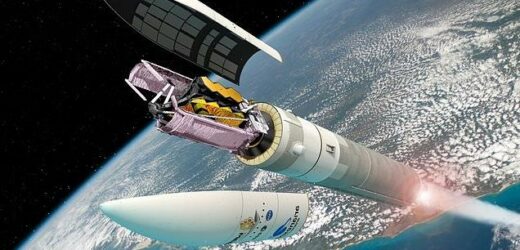NASA’s James Webb telescope is ‘go’ for launch! $10 BILLION spacecraft passes its final review and will be sent into space on Halloween
- The James Webb space telescope has cost $10 billion (£7.3 billion) to develop
- It will launch to the L2 point between Earth and the Sun from October 31, 2021
- It has been plagued by delays and problems including with the launch vehicle
- It will go up to space on an Ariane 5 rocket from French Guiana after a technical review by Arianespace confirmed everything was working as expected
The James Webb space telescope, a joint NASA, European and Canadian mission, has been given a ‘go’ to launch after it and the rocket launcher passed a final review.
The $10 billion (£7.3 billion) space-based observatories has been beset by delays, including with the European Space Agency (ESA) funded Ariane 5 launch vehicle.
It will take off no earlier than October 31 from Europe’s spaceport in French Guiana, with the review marking a major milestone in its 25 year development program.
The review was carried out by Arianespace, the Webb launch service provider, confirming that Ariane 5, the spacecraft and the flight plan are set for launch.
It also specifically provides the final confirmation that all aspects of the launch vehicle and spacecraft are fully compatible, something that led to earlier delays.
The James Webb space telescope, a joint NASA, European and Canadian mission, has been given a ‘go’ to launch after it and the rocket launcher passed a final review
Supported by NASA, the European Space Agency (ESA) and the Canadian Space Agency (CSA), it has a massive 21ft 4 inch mirror that was commanded to fully expand and lock itself into place, replicating the process that will happen in space
ARIANE 5: THE EUROPEAN HEAVY-LIFT LAUNCH VEHICLE
Ariane 5 is the European heavy-lift space launch vehicle. It was developed and is operated by Arianespace for the European Space Agency and launched out of French Guiana.
It sends satellites into geostationary and low Earth orbit and has an 82 consecutive successful streak since first launch in 2003.
It was built by Aribus and costs up to €185 million (£159 million) per launch to get a payload into space.
It has a height of 171ft over the two stages and can take a maximum payload of 23,953lb.
Ariane 5 is the launch vehicle of choice to send the James Webb space telescope to the L2 point.
Construction on the JWST began in 1996, with a $500 million budget and proposed 2007 launch, but constant set backs, production issues and later issues pairing the folding observatory with Ariane 5, led to a spike in the budget and late launch.
The final development cost for the mission came in at $15 billion and it has an estimated lifespan of at least a decade, although may run for longer.
During launch, the spacecraft experiences a range of mechanical forces, vibrations, temperature changes, and electromagnetic radiation.
All technical evaluations performed by Arianespace on the mission’s key aspects, including the launch trajectory and payload separation, have shown positive results.
This is essential due to the cost of the telescope, which has to fold itself up inside the fuselage, before unfolding again once in space.
“We are thrilled to have passed this important step towards the launch of Webb and to have received the green light from Arianespace and NASA,” says Peter Rumler, ESA Webb project manager.
Webb will be the largest, most powerful telescope ever launched into space.
As part of an international agreement, ESA is providing the observatory’s launch service using the Ariane 5 launch vehicle for the NASA-built telescope.
Ariane 5 will deliver the telescope directly into a precision transfer orbit towards its destination, the second Lagrange point (L2).
A Lagrange point sits between two large orbiting bodies, in this case the Sun and Earth and L2 sits in the centre of the two bodies.
After separation from the launcher, Webb will continue its four-week long journey to L2 alone, before becoming established and beginning observations.
L2 is four times farther away than the Moon at about 932,000 miles (1.5 million km) from Earth in the direction away from the Sun.
It will take off no earlier than October 31 from Europe’s spaceport in French Guiana, with the review marking a major milestone in its 25 year development program
NASA recently unfolded the giant mirror of the James Webb Space Telescope ‘like a piece of origami artwork’ one last time ahead of its launch later this year
INSTRUMENTS ON THE JAMES WEBB SPACE TELESCOPE
NIRCam (Near InfraRed Camera) an infrared imager from the edge of the visible through the near infrared
NIRSpec (Near InfraRed Spectrograph) will also perform spectroscopy over the same wavelength range.
MIRI (Mid-InfraRed Instrument) will measure the mid-to-long-infrared wavelength range from 5 to 27 micrometers.
FGS/NIRISS (Fine Guidance Sensor and Near Infrared Imager and Slitless Spectrograph), is used to stabilise the line-of-sight of the observatory during science observations.
Mission analysis experts at ESA helped to compute the launch window, a complex issue because it involves ensuring that Webb can be inserted into its target orbit and at the same time the Ariane 5 upper stage will safely escape from Earth.
The telescope will observe the Universe in the near-infrared and mid-infrared – at wavelengths longer than visible light. To do so, it carries a suite of state-of-the-art cameras, spectrographs and coronagraphs.
Aside from procuring the Ariane 5 launcher and launch services, ESA is contributing the NIRSpec instrument and a share of the MIRI instrument.
The first images will be test shots, rather than of anything specific, but it will act as a ‘cosmic time machine’ when fully operating, probing deeper into the Universe than ever before.
Up to 30 per cent of the first year of observations will be aimed at exoplanets, to study their orbit, size and atmosphere, in search of alien life.
‘Webb will ship to the launch site in August with little to no schedule margin,’ the NASA spokesperson said in an earlier email to DailyMail.com.
‘Launch processing will take two months. The observatory has completed all the post-environmental testing deployments, and it’s in its final integration and folding stages. Final stow, closeout, and pack and ship are imminent.’
NASA’s James Webb Space Telescope will launch ‘no earlier than October 31,’ a NASA spokesperson told DailyMail.com
Scientists may find ALIENS by 2026 thanks to the Webb telescope
The existence of life on another planet could be proved as early as 2026 thanks to the James Webb telescope.
It has the ability to detect signatures made by living creatures and Ohio State researchers say it could find ‘life’ on another planet in under 60 hours.
Graduate student Caprice Phillips said the results of her study show that we may ‘realistically find signs of life in the next 5 to 10 years.’
Phillips calculated that when the James Webb Space Telescope launches in October, it could feasibly detect ammonia around gas dwarf planets after just a few orbits.
In July 2020, the launch of the telescope was pushed back to October 31, 2021 from March 2021, due in part to the COVID-19 pandemic.
It was initially scheduled to launch as early as 2007, however the telescope has faced a number of delays in recent years.
Some of the delays have been technical issues, which have raised the price of the telescope from the initial estimate of $1.6 billion to the $10 billion it currently costs.
One of the most important parts of the mission is the the five-layer sunshield, which NASA has said previously said is “designed to keep Webb’s mirrors and scientific instruments cold by blocking infrared light from the Earth, Moon and Sun.”
In August 2019, NASA announced that it had successfully assembled the craft, marking the biggest milestone of its long road to completion.
It will offer unprecedented insight into the atmospheric composition of gas dwarf planets.
The massive telescope will be used to look back to the first galaxies born in the early universe more than 13.5 billion years ago.
It will observe the sources of stars, exoplanets, as well as the moons and planets in the solar system.
In doing so, it will use the most advanced technologies to make observations including infrared light, learning about atmospheres of target worlds that have entirely different chemistry from Earth.
Earlier this year, researchers at The Ohio State University said the telescope could detect a signature of life on other planets in as little as 60 hours.
Ryan King, Space Science Programme Manager at UK Space Agency, said James Webb will ‘fundamentally alter our understanding of the universe.’
‘UK scientists, researchers, and engineers have played a crucial role in developing MIRI,’ an instrument integral to the operations of the telescope.
‘[It] will allow us to examine the physical and chemical properties of the early universe, as well as the stars and planetary systems forming today.
‘The telescope will bring us one step closer to understanding the processes that ultimately led to the origins of life.’
JAMES WEBB SPACE TELESCOPE: THE NEXT BIG ORBITAL OBSERVATORY DEPLOYED TO SEARCH FOR ALIEN LIFE
NASA and partners plan to launch their next major space telescope later this year and it will serve as the natural successor to Hubble.
Primarily an infrared telescope, it will have a wider spectrum view than Hubble and operate further out from the Earth, in a solar orbit, rather than an Earth orbit.
Research by Ohio State University claims that within five years of it coming online, James Webb will have found signs of alien life on a distant world.
Graduate student Caprice Phillips calculated that it could feasibly detect ammonia created by living creatures around gas dwarf planets after just a few orbits.
The James Webb telescope has been described as a ‘time machine’ that could help unravel the secrets of our universe.
The telescope will be used to look back to the first galaxies born in the early universe more than 13.5 billion years ago.
It will also observe the sources of stars, exoplanets, and even the moons and planets of our solar system.
The James Webb Telescope and most of its instruments have an operating temperature of roughly 40 Kelvin.
This is about minus 387 Fahrenheit (minus 233 Celsius).
Officials from the space agencies responsible for the telescope say the cost may exceed the $8 billion (£5.6 billion) program cap set by Congress.
NASA has already poured $7 billion (£5 billion) into the telescope since it was first proposed as a replacement for the long-running Hubble space telescope.
When it is launched in 2021, it will be the world’s biggest and most powerful telescope, capable of peering back 200 million years after the Big Bang.
James Webb is designed to last for five years but NASA hopes it will operate for a decade or more, although due to its distance from Earth it can’t be easily repaired.
It is 66ft by 46ft and will operate at the Sun-Earth Lagrange point about 930,000 miles from the Earth – almost four times further out than the moon.
The telescope is set to launch on a European workhorse Ariane-5 rocket at the end of October 2021, with the first observations expected in 2022.
Source: Read Full Article







